Mastering Pork and Shrimp Dumplings: A Culinary Guide
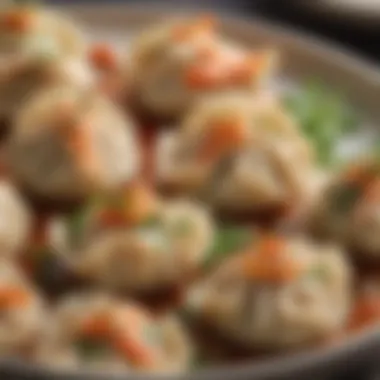
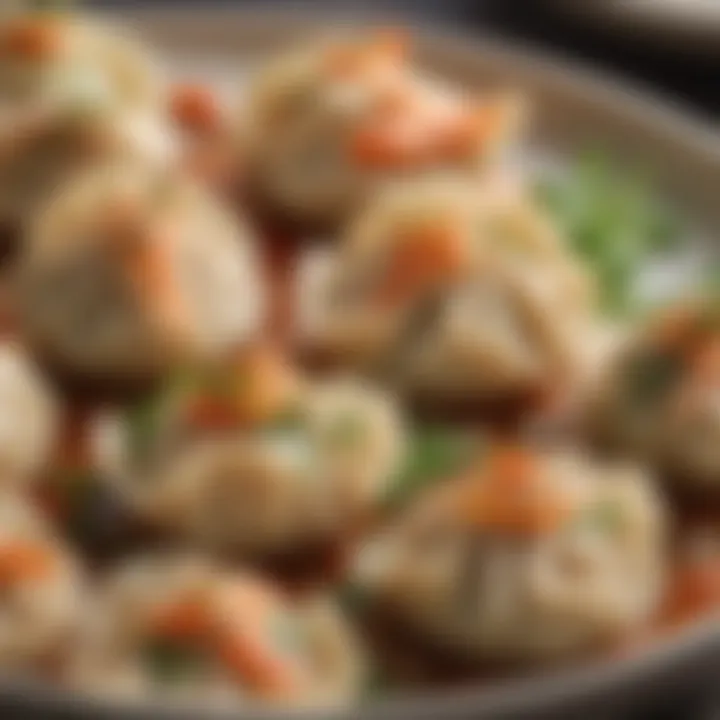
Intro
Pork and shrimp dumplings stand as a beloved staple in many culinary traditions, weaving a rich tapestry of flavor, texture, and history. These charming morsels offer not only a delicious bite but also a glimpse into the melding of cultures that have influenced their evolution over the centuries. Originating from various regions of Asia, they embody the essence of communal dining and shared experiences.
Whether enjoyed steamed, fried, or boiled, dumplings capture the imagination of food lovers and home cooks alike. The careful artistry involved in their preparation speaks to a time-honored craft passed down through generations.
As we embark on this exploration of pork and shrimp dumplings, we will uncover the nuances of their preparation, dive into intriguing variations, and share invaluable tips to elevate your dumpling game. Get ready to roll up your sleeves and indulge in a culinary journey that promises both satisfaction and creativity.
Recipe Highlight
Savory Shrimp and Pork Dumplings
Calling all lovers of fine dumplings! One standout recipe that captures the essence of flavor is Savory Shrimp and Pork Dumplings. This option marries the sweetness of shrimp with the hearty richness of pork, creating a delightful blend that will have your taste buds dancing.
Essential Ingredients
To craft this dish, you’ll need the following ingredients:
- 1 cup minced pork
- 1 cup chopped shrimp
- 2 tablespoons soy sauce
- 1 tablespoon sesame oil
- 1 teaspoon ginger (grated)
- 2 green onions (finely chopped)
- Dumpling wrappers
- Salt and pepper to taste
Estimated Time
Preparation: around 30 minutes
Total Cook Time: 20 minutes
Yields: Approximately 24 dumplings
Step-by-Step Instructions
- Prepare the filling: In a mixing bowl, combine the minced pork and chopped shrimp. Add soy sauce, sesame oil, grated ginger, and chopped green onions. Season with salt and pepper, mixing thoroughly.
- Assemble the dumplings: Take a dumpling wrapper and place about one tablespoon of the filling in the center. Wet the edges of the wrapper, fold it in half to create a semi-circle, and pinch the edges to seal, ensuring no air is trapped inside.
- Cook the dumplings: You can either steam the dumplings for about 15 minutes or pan-fry them for about 5 minutes on one side and then add a small amount of water before covering to steam until cooked through.
- Serve: Pair the dumplings with your favorite dipping sauce, and enjoy the burst of flavor with each bite.
Insider Advice
To avoid common pitfalls, ensure your dumpling wrappers are slightly moist while working with them. This prevents them from drying out and cracking while you assemble.
Variations and Substitutions
Feel free to get creative! If you prefer something plant-based, substitute with tofu and mushrooms to create a vegan option. You can add spices like five-spice powder for an extra layer of flavor.
Pairing Suggestions
Best served with a side of hot and sour soup or simple stir-fried greens, these dumplings can easily adapt to your dining table.
Time-Saving Cooking Tips
Designate a day for meal prep where you can prepare larger batches of dumplings for the week. Store them in the freezer; they steam beautifully from frozen.
Using a food processor to finely chop shrimp and other ingredients can save you considerable time during the prep phase.
Nutritional Information
Calories per serving: Approximately 150 calories
Key Nutrients
- Protein: 12 grams
- Total fat: 7 grams
- Fiber: 1 gram
This dish is a source of high protein, making it suitable for active individuals, while the fiber makes it a well-rounded meal option. For those on gluten-free diets, alternatives for dumpling wrappers can be found easily in stores or homemade from rice flour.
To dive deeper into the world of dumplings and their significance, check out Wikipedia or engage with communities on Reddit. Learn and share experiences to enhance your culinary adventures.
Prelude to Pork and Shrimp Dumplings
Dumplings have long been an integral part of many cuisines around the world, and among them, pork and shrimp dumplings stand out for their unique flavor and versatility. They are not just a dish; they are a celebration of culinary craftsmanship that engages all the senses. In this section, we delve into what makes these delicacies so special, laying the groundwork for a comprehensive exploration in the following sections.
The significance of pork and shrimp dumplings lies in their rich history and the cultural traditions they embody. They are often linked to gatherings, celebrations, and family meals. The blend of succulent pork and fresh shrimp creates a harmonious flavor profile that translates into an appreciation for well-prepared food. This article will help you understand how to master this art form in your kitchen, from the selection of ingredients to the final presentation of the dish.
In practical terms, understanding pork and shrimp dumplings provides numerous benefits. For one, they offer an exciting opportunity to experiment with flavors and cooking techniques. By learning the nuances of this dish, cooks can elevate their skills and impress friends and family. Moreover, these dumplings can be tailored to suit various dietary preferences or restrictions, making them inclusive and adaptable.
In addition, there’s a timeless appeal to dumplings that draws both novice and experienced cooks alike. It’s about the process—the kneading of dough, combining ingredients, and perfecting cooking methods. As you read through this article, you'll gain insights that will enable you to embrace the tradition while adding your personal touch, ensuring that every plate tells a story.
"Cooking is an act of love, and dumplings are a heartfelt way to express it."
This section aims to set the stage for the subsequent discussions on historical context, key ingredients, and preparation techniques. By grasping the fundamentals, you’ll be more equipped to dive deeper into each element that comes into play in crafting authentic pork and shrimp dumplings. As we move forward, you’ll find that every aspect contributes to the overall experience, enriching not only your cooking repertoire but also your understanding of a culinary art cherished by many.
Historical Context
The journey into pork and shrimp dumplings is paved with a rich historical backdrop that reflects the culinary nuances of various cultures. Understanding the historical context enriches our appreciation of these delightful morsels, shedding light on how they became a staple in diverse cuisines around the world.
Culinary Traditions
Dumplings are not merely a meal; they represent a tapestry of cultural expression and heritage. Across Asia, particularly in China, dumplings have long been associated with family gatherings and traditional festivals. For instance, during the Chinese New Year, families come together to prepare dumplings, symbolizing wealth and prosperity as the shapes often resemble ancient currency.
In regions like Eastern Europe, dumplings take on different shapes and fillings, often serving as a comfort food during harsh winters. Varieties such as pierogi resonate deeply within Polish culture, embodying the essence of community and home-cooked warmth. It’s fascinating to see how local ingredients and customs transform the basic concept of a dumpling into something unique.
As customs traveled through trade routes and migration, they left an imprint in the culinary practices of the regions they touched. Dumplings can thus be seen as a kind of cultural anthropologist, telling stories of the people who make and consume them. This historical significance informs recipes and helps cooks appreciate the flavors tied to their history.
Evolution of Dumpling Recipes
The evolution of dumpling recipes is a testament to human creativity and adaptability in the kitchen. Early versions of dumplings were quite rudimentary. The fillings were often simple, utilizing whatever ingredients were available. A typical mixture might include seasoned meat, a splash of aromatic herbs, and perhaps some vegetables from the garden. But over the centuries, these recipes have undergone significant transformation.
Today, you can find an array of interpretations—ranging from traditional pork and shrimp dumplings in a delicate broth to modern twists featuring international flavors. Cuisines such as Vietnamese, with their bánh xèo, and Japanese, with gyoza, show how local preferences influence the flavor profiles of dumplings.
Culinary innovations have led to experimentation with variants like gluten-free wrappers, vegan fillings, and new cooking methods like air-frying, making dumplings more accessible to a broader audience. The blend of traditional techniques with contemporary culinary methods represents not just a change in how dumplings are enjoyed, but also a reflection of changing dietary habits and food availability.
"Food is not just sustenance; it carries stories of our past and contributes to our future."
In summary, the historical context sets the stage for understanding why pork and shrimp dumplings occupy such a cherished place in various culinary traditions. It is through exploring these layers of history that we begin to see dumplings not just as food, but as an essential part of our shared human experience, connecting generations and cultures across the globe.
Key Ingredients
When it comes to crafting the perfect pork and shrimp dumplings, the ingredients you choose play a pivotal role. Each component not only enhances the flavor but also contributes to the texture and authenticity of the dish. The quality of your ingredients can make the difference between a mediocre dumpling and one that leaves diners yearning for more. Here’s a closer look at the essentials that elevate these delightful treats.
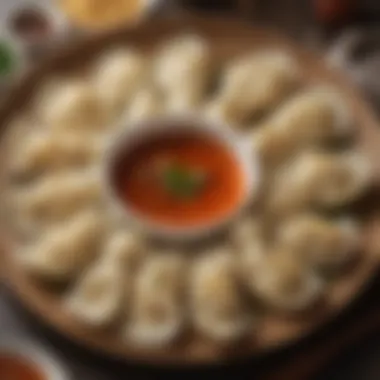
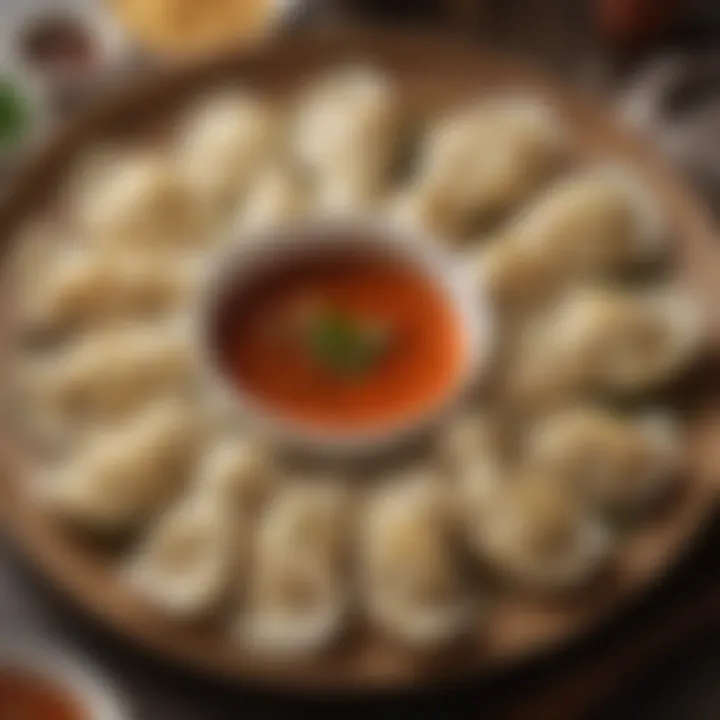
Choosing the Right Pork
Selecting the ideal pork is fundamental. The meat's fat content can alter the mouthfeel and juiciness of the filling. For dumplings, pork shoulder often takes the cake because of its combination of meat and fat. This cut delivers a rich flavor while also ensuring that the filling remains moist, which is crucial when the dumplings are cooked.
A good rule of thumb is to aim for pork with at least 20% fat. This balance not only adds a delightful richness but also helps the filling hold together during cooking. Keep an eye out for lean cuts; they might sound healthy but can lead to dry dumplings.
Additionally, try to source meat from local butchers when possible, as they can provide cuts that are fresher and often of better quality than mass-produced options.
Selecting Shrimp
Shrimp brings a unique sweetness that pairs beautifully with pork. Choosing fresh and firm shrimp can be a game-changer in flavor. Opting for wild-caught shrimp is recommended over farmed varieties—this choice often ensures superior taste and texture.
Look for shrimp that has a sweet aroma and a firm body. When purchasing, consider sizes. Larger shrimp might seem enticing, but medium shrimp work just as well. The key is to ensure they are deveined and peeled for convenience. If you can, shop locally; fresher shrimp tends to yield a more vibrant taste.
Essential Seasonings and Fillers
While the main proteins—pork and shrimp—stand tall, the seasonings and fillers compose the symphony of flavors that elevate your dumplings. Some of the most important ingredients to consider include:
- Soy sauce: Adds saltiness and umami for depth.
- Sesame oil: Imparts a nutty aroma, enhancing the dish’s overall profile.
- Ginger and garlic: Key aromatics that provide warmth and richness.
- Green onions: Offers a fresh element, balancing out the richness of the meat.
- Water chestnuts: For a delightful crunch that contrasts with the soft dumpling.
By blending these components effectively, you create a filling bursting with flavor, ensuring that each bite is a harmonious mix of texture and taste. Experimenting with different combinations can lead to delightful surprises.
"Good cooking is about the intelligence of choosing and combining ingredients." Whether you opt for traditional pairings or try something new, remember that flavor and freshness are paramount in your dumpling adventure.
Preparing Dumpling Wrappers
In the culinary universe of pork and shrimp dumplings, the wrapper serves as a vessel, cradling the delightful filling within. Properly prepared dumpling wrappers can elevate even the simplest filling into a star dish. Therefore, understanding the methods of preparing these wrappers can make or break your dumpling experience. While they may seem secondary, they are integral to the texture and taste of the end product.
When you bite into a well-crafted dumpling, the balance between the soft yet firm wrapper and the succulent filling is what creates that satisfying experience. A two-fold process goes into making the wrappers: a good recipe followed by the skill to handle the dough. In this section, we will explore the choice between homemade and store-bought wrappers, along with techniques to achieve the best results.
Homemade vs. Store-Bought
The debate between using homemade versus store-bought dumpling wrappers is akin to choosing between fresh bread and pre-packaged sandwiches. Each has its merits, but if quality is your aim, making them from scratch definitely carries a certain allure.
Homemade Wrappers:
- Freshness: Nothing beats the taste of freshly made dough. You get to control the quality and texture.
- Customization: You can adjust the thickness or even incorporate ingredients like spinach or beet juice for color and flavor.
- Skill Development: Making your own allows you to learn the intricacies of dough handling.
However, homemade wrappers require time and practice. If you are short on time or just starting your dumpling-making journey, homemade may not be feasible.
Store-Bought Wrappers:
- Convenience: These wrappers save you time and effort. They come ready to use, allowing you to focus more on filling and cooking.
- Consistency: They often provide reliable quality and thickness.
- Availability: Many stores offer a variety of options, including gluten-free and thin wrappers, making them accessible for everyone.
If you're inclined to experiment, you could compromise. Use store-bought wrappers for practice, and once you’ve mastered the filling, venture into making your own.
Techniques for Perfect Wrappers
Creating the perfect dumpling wrapper involves careful technique and a pinch of patience. Here are some detailed steps to guide you:
- Ingredients: Start with simple ingredients: all-purpose flour and water. Some recipes may suggest adding a bit of salt or oil.
- Dough Preparation:
- Rolling Out:
- Preventing Sticking: Dust your wrappers lightly with flour to avoid sticking together. You can also use parchment paper between layers if stacking.
- Filling Tips: Make sure to only fill the wrappers just before you plan on cooking them. An overfilled or pre-filled dumpling is likely to lose shape or burst during cooking.
- Combine flour and water in a bowl. Gradually knead until a smooth dough forms. If the dough is too sticky, add a little more flour. Conversely, if it's too dry, sprinkle in some water.
- Once it’s smooth, cover it with a damp cloth and let it rest for about 30 minutes. Resting helps to relax the gluten, which is crucial for elasticity.
- Take a small piece of dough and roll it out on a floured surface until it’s thin and even. Aim for a thickness of about 1-2 millimeters. If it’s too thick, the wrappers won’t cook properly; if too thin, they won't hold the filling.
- Use a sharp round cutter or a glass to cut out circles.
Through these techniques, anyone can create soft yet strong dumpling wrappers, setting the foundation for delicious pork and shrimp dumplings. Each little success in the kitchen contributes to your culinary skillset, creating a rewarding and enriching experience.
Filling the Dumplings
Filling the dumplings is a critical stage in the creation of pork and shrimp dumplings. This part of the process not only defines the flavor and texture of the final product but also serves as a canvas for the cook's creativity. A well-prepared filling can transform simple ingredients into a dish that tells a story and captures the essence of culinary traditions.
Combining Ingredients
The first step in this mesmerizing journey is combining ingredients. It sounds straightforward, but there's an art to achieving that perfect balance of flavors. Core ingredients typically include finely chopped pork and shrimp—opt for fresh, high-quality protein. You'd want to choose pork shoulder for its rich fat, giving the dumpling a succulent texture.
When blending the shrimp, a tip is to coarsely chop it instead of pureeing it. This ensures you’ll maintain some bite—nobody likes a filling that's just a mushy paste. Consider this mix:
- Chopped garlic and ginger add some zest and swing
- Green onions contribute a fresh crunch
- Soy sauce or oyster sauce brings the umami flavor you're after
- Sesame oil adds richness
- A sprinkle of white pepper for a gentle kick
You want to toss the ingredients together in a bowl, using your hands to ensure everything is evenly mixed. Feel free to taste as you go; the flavor should pop but not overshadow the delicate shrimp. Adjust seasonings gradually, because, hey, it’s easier to add than to take away!
Proper Packing Techniques
Now that you have a delectable filling ready, it’s time to move on to proper packing techniques. This step is where many novice cooks stumble as they misjudge the balance between overfilling and underfilling.
Start with a small amount of your delicious mixture. A teaspoon is typically a good guideline. Place it in the center of your dumpling wrapper. Then comes the crucial part: shaping the dumpling.
- Fold the wrapper in half, ensuring the filling is snugly placed.
- Pinch the edges firmly to create a seal, ensuring no filling escapes during cooking. You can pleat the edges if you want to get fancy—some cooks find pleasure in the aesthetics of those little folds.
- If it seems dry and not sticking, a dab of water on the edge can work wonders.
It’s a delicate dance, this packing part. Remember, too tight means exploding dumplings, but too loose can lead to filling leaks. Aim for that sweet spot where the dumpling holds its form but remains tender on the bite. This skill will come with practice, so don't sweat it if your first few don't look like they’re Michelin starred.
In summary, filling dumplings is a mix of ingredient harmony and proper techniques. With a few attempts, you'll soon be churning out examples that would make any culinary enthusiast proud.
Cooking Methods
When it comes to pork and shrimp dumplings, the cooking methods you choose can truly make or break your dish. Each technique subtly alters the flavor, texture, and overall experience, providing a multitude of options for cooks of any skill level. Exploring these methods opens up an avenue for creativity while ensuring your dumplings are both satisfying and delicious.
A good understanding of various cooking techniques can help you maximize the potential of your dumplings. Whether you aim for soft, juicy bites or crispy, golden exteriors, each method has its own merits worth considering. Let’s dive into the specifics of each technique.
Steaming Techniques
Steaming is arguably one of the most revered ways to cook dumplings. This method not only preserves the flavor of the fillings but also keeps the wrappers tender and moist. Traditional bamboo steamer baskets are a common choice, lending an authentic touch to the cooking process. What’s essential here is to ensure your steamer is lined—using parchment paper or cabbage leaves can prevent sticking.
The steam does wonders for your dumplings, infusing them with flavor from any herbs or spices you may have added. The added moisture is a great ally, keeping your fillings warm and ensuring that you don't end up with a dried-out lump.
- Temperature Control: Keeping an eye on the temperature is crucial. Too high, and you risk a like chewy texture; too low can result in undercooked dumplings.
- Timing Matters: Most dumplings require about 10-15 minutes to steam. Using a timer can save you from overcooking, leading to a delightful bite every time.
Properly steamed dumplings will bloat slightly, showcasing their fluffiness and inviting texture.
Boiling and Pan-Frying
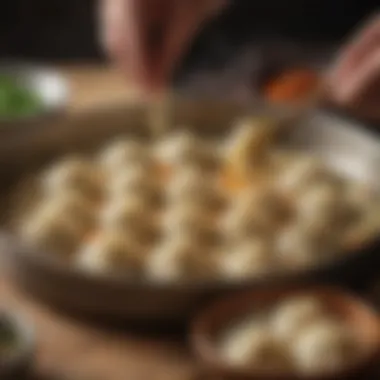
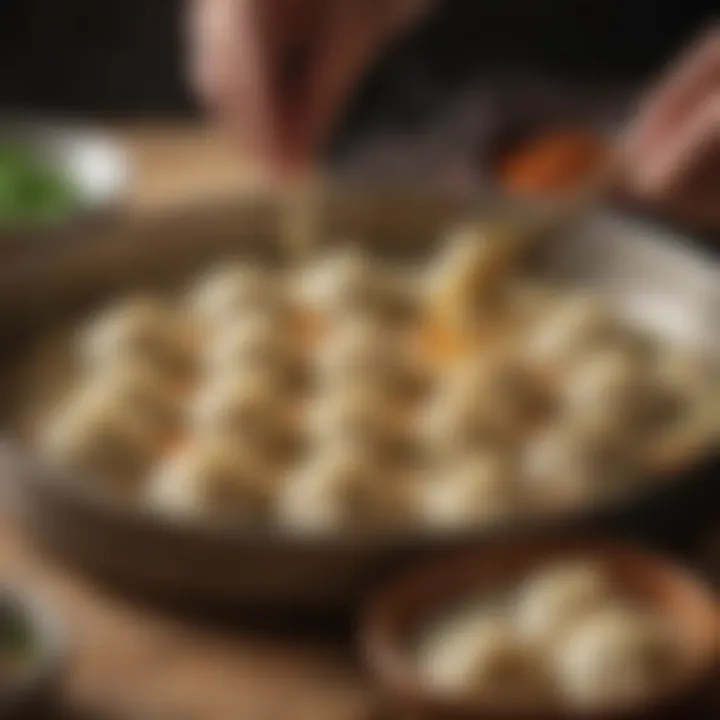
Boiling dumplings is often the go-to method when you’re aiming for ease and simplicity. It’s quite straightforward—water, heat, and some salt create the perfect cooking environment. The trick here lies in ensuring that the water is at a rolling boil before adding dumplings to avoid clumping. Over a few minutes, the dumplings will float to the surface when they’re ready, a visual cue of doneness.
For added texture and flavor, pan-frying shows another side of culinary creativity. By frying the boiled dumplings in a small amount of oil, you create a crispy base while preserving the steam technique’s soft interior.
- Tips for pan-frying:
- Heat your pan before adding dumplings to get an immediate sear.
- Adding a splash of water and covering the pan helps steam the dumplings after frying, packing in flavor.
- Golden brown is the name of the game; check regularly to avoid burning.
Innovative Cooking Methods
In recent years, innovative cooking methods have entered the dumpling scene, elevating this traditional dish to new heights. One such method includes sous-vide, a technique that slowly cooks food in a vacuum-sealed bag in a water bath at a precise temperature. This promises every filling is cooked evenly while retaining moisture, leading to perfectly textured dumplings.
Another method gaining traction is air frying. This option provides a crispy outer layer with dramatically less oil than traditional frying, making it a healthier choice. Plus, air frying brings out unique flavors from the wrappers and fillings as the hot air circulates around them.
For those looking for excitement in their culinary adventures, try grilling dumplings over an open flame. This charred approach offers a smoky flavor that steams to perfection as the dumplings cook. Think of it as a surprising twist on the classic, appealing to adventurous palates.
Each of these innovative techniques not only modernizes the cooking process but also allows for additional creativity in flavor and presentation. Embrace these methods, and who knows? You might just find a new favorite way to serve up those pork and shrimp dumplings.
Serving Suggestions
When it comes to savoring pork and shrimp dumplings, the way they are served can elevate the dish from simply good to delightfully memorable. It's not just about how the dumplings taste on their own, but also the complementary elements that bring out their unique flavors. This section will cover essential serving ideas that not only enhance the dining experience but also keep the authenticity of the dish intact.
Traditional Dipping Sauces
Dipping sauces are the unsung heroes of dumpling dishes. Without them, even the fluffiest, most flavorful dumpling can feel a touch incomplete. A well-crafted dipping sauce creates contrast and depth, bringing a whole new dimension to your meal. Here are a few classic choices that perfectly pair with pork and shrimp dumplings:
- Soy Sauce: A staple that plays well with every type of dumpling. It acts as a foundation, offering saltiness that elevates the meat and shrimp.
- Chili Oil: For those who like a kick, adding chili oil introduces heat that can complement the savory flavors of the dumplings. It's spicy, aromatic, and oh-so-satisfying.
- Vinegar Dip: A mixture of rice vinegar and soy sauce can bring a tangy twist. It cuts through the richness and provides a refreshing palate cleanser with each bite.
- Sesame Sauce: This gives an earthy flavor that pairs well with the other dipping options, adding creaminess and warmth.
A little drizzle of sesame oil as a finishing touch can tie everything together.
To amplify your serving game, think about incorporating fresh grated ginger or chopped scallions into the sauces for added zing. It's a detail that shows you’re taking the time to appreciate the dish.
Pairing with Sides
Sides are the finishing touches that can make a meal feel complete. When selecting sides to serve alongside your dumplings, it helps to think about balancing flavors and textures. Here are some ideas to consider:
- Steamed Bok Choy: The subtle bitterness and crunch of bok choy acts as a great counterbalance to the rich, savory dumplings. A quick steam enhances its natural flavor without overshadowing the star of the show.
- Pickled Vegetables: Adding some pickled veggies not only introduces a delightful zing but also adds color to your plate. They can range from pickled radish to kimchi, creating a contrast that invigorates your palate.
- Noodle Salad: A light, refreshing noodle salad dressed in sesame oil or a soy-based dressing can serve as a hearty accompaniment. It's an excellent way to get some extra texture in the meal while remaining light enough not to overshadow the dumplings.
- Rice: If you want to go more traditional, serve the dumplings with a side of jasmine rice. It’s a neutral base that lets those gorgeous dumplings really shine.
In summary, serving pork and shrimp dumplings isn’t solely about plating them prettily; it’s equally about the experience of flavors you create alongside. Don’t be afraid to experiment with different sides and sauces until you find the perfect combination that delights your taste buds.
Variations of Dumplings
Dumplings, particularly the delightful combinations of pork and shrimp, showcase a remarkable versatility that transcends cultures and cuisines. This section emphasizes the significance of the variations found in dumpling preparation and how they reflect local tastes and traditions. Dumplings are not just meals; they are significant cultural artifacts that tell the story of a community's history, ingredients, and preferences.
When exploring variations, one might think of regional specialties that utilize local ingredients, tailoring the flavors and textures to suit various palates. Besides regional influences, creative adaptations arise from modern culinary trends, reinterpreting traditional recipes with innovative twists, leaving room for gastronomic exploration. These variations not only enrich the culinary landscape but also provide insight into how food evolves, reflecting both tradition and modernity.
Exploring these aspects equips home cooks and culinary enthusiasts with diverse options, encouraging them to experiment in their kitchens. Understanding various approaches can greatly expand the home chef's repertoire while fostering cultural appreciation and respect for global cuisine.
Regional Variants
Dumplings manifest distinctly across regions, each with its unique flair that resonates with local traditions. For example, in northern China, one may encounter jiaozi, characterized by a thicker wrapper filled with pork and shrimp, often steamed or boiled. These dumplings are typically enjoyed during celebrations, especially the Lunar New Year, signifying wealth and prosperity.
In contrast, the har gow found in Cantonese dim sum offers a transparent wrapper made from rice flour, delicately encasing minced shrimp. This variation, considered a symbol of luxury, is usually served with a soy-based dip, emphasizing the shrimp’s sweetness and freshness.
Moreover, countries like Japan present their own twist with gyoza, featuring a thin, slightly crispy wrapper filled with a blend of pork, shrimp, and should traditionally include garlic chives. This adaptation often gets pan-fried, allowing for a delightful contrast between the tender filling and a crunchy exterior. On the other hand, in places like Vietnam, bánh bao are more akin to buns, often steamed and larger, filled with various mixtures including pork or seafood.
The regional variants provide a canvas for understanding how geography, agriculture, and cultural influences intertwine to create a rich tapestry of flavors that makes dumplings a beloved dish worldwide.
Creative Adaptations
Innovation in the culinary field knows no bounds, and dumplings are ripe for modern reinterpretation. Daring chefs and home cooks alike have taken traditional pork and shrimp dumpling recipes and crafted them into contemporary delights that reflect changing palates and dietary needs.
Consider the use of alternative wrappers, such as kale or rice paper, especially for health-conscious individuals or those seeking gluten-free options. This not only alters the nutritional profile of the dumpling but adds interesting visual appeal and texture.
Another creative adaptation includes experimentation with fillings. While traditional recipes lean heavily on soy sauce, ginger, and sesame oil, one might find dumplings today stuffed with ingredients like spicy chorizo or even crab meat, providing a completely new flavor profile.
The rise of fusion cuisines introduces unexpected pairings, like dumplings filled with avocado or spiced with harissa, creating a delightful blend of cultures on one plate. Chefs also play with cooking methods, using air fryers for a healthier crispy finish or experimenting with sous-vide techniques to perfect the texture of the filling.
These creative adaptations illuminate how dumplings can be versatile and appealing to a wider audience, reshaping perceptions of traditional meals while inspiring chefs to break free from the norm.
"Dumplings are not just about food; they capture a sense of belonging, tradition, and creativity that transcends borders."
Dumplings in Culture
Dumplings play a significant role beyond being mere food items; they embody culture, history, and tradition. This section underscores the multifaceted importance of pork and shrimp dumplings in various societies. Cultures around the world often regard dumplings as a source of comfort and community. They come with stories, connections, and a wealth of culinary practices that transcend borders. Understanding this cultural significance adds layers of appreciation to each bite.
Culinary Significance
The culinary significance of dumplings stretches far and wide. They are not just a staple in many cuisines, but also a culinary canvas that reflects regional flavors and traditions. Many families have recipes passed down through generations, reinforcing a sense of identity. In Chinese culture, for instance, dumplings symbolize wealth and prosperity, often enjoyed during the Lunar New Year celebrations.
Moreover, dumplings serve practical purposes in culinary practices. They maximize the use of available ingredients, often acting as a way to stretch food supplies in resourceful homes. This aspect of dumplings illustrates how communities adapt their cooking to both cultural and economic contexts. The unique combinations of pork and shrimp in various dumpling recipes are a testament to the creativity found in kitchens worldwide.
Dumplings in Festivals
Dumplings also celebrate cultural festivals worldwide, which further highlights their importance. In many Asian cultures, special occasions are often marked with dumplings as the centerpiece of feasting. For instance, the Chinese New Year sees families gather to make dumplings together, a tradition known as "jiaozi." This activity isn't just about eating; it's about bonding, storytelling, and sharing aspirations for the year ahead.
- Major festivals celebrating dumplings include:
- Chinese New Year: Symbolizes new beginnings and prosperity.
- Winter Solstice: Marks the return of longer days; families often eat dumplings for warmth.
- Tết (Vietnamese New Year): Celebrates family through the making and sharing of Vietnamese dumpling varieties.
Whether in large festival banquets or intimate family gatherings, dumplings hold a prominent place on the table, showcasing not only culinary artistry but also reinforcing community ties.
Dumplings in various cultures embody stories and traditions, acting as delicious bridges between generations and communities.
In essence, dumplings are much more than a delightful dish; they represent the shared stories of cultures, the making of memories, and the cornucopia of flavors that arise when history meets modern taste.
Nutritional Aspect
When discussing pork and shrimp dumplings, the nutritional aspect plays a pivotal role. It’s not merely about the taste—although, make no mistake, that’s a huge part of it; but also about how these delightful morsels fit into a balanced diet. This section breaks down key nutritional components, considers health implications, and highlights how culinary enthusiasts can enjoy these dumplings without compromising their well-being.
Analyzing Macronutrients
Pork and shrimp dumplings pack a nutritional punch. Let’s first look at the core macronutrients:
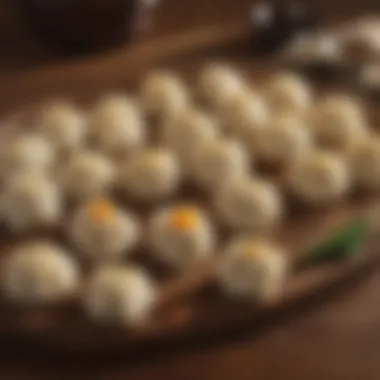
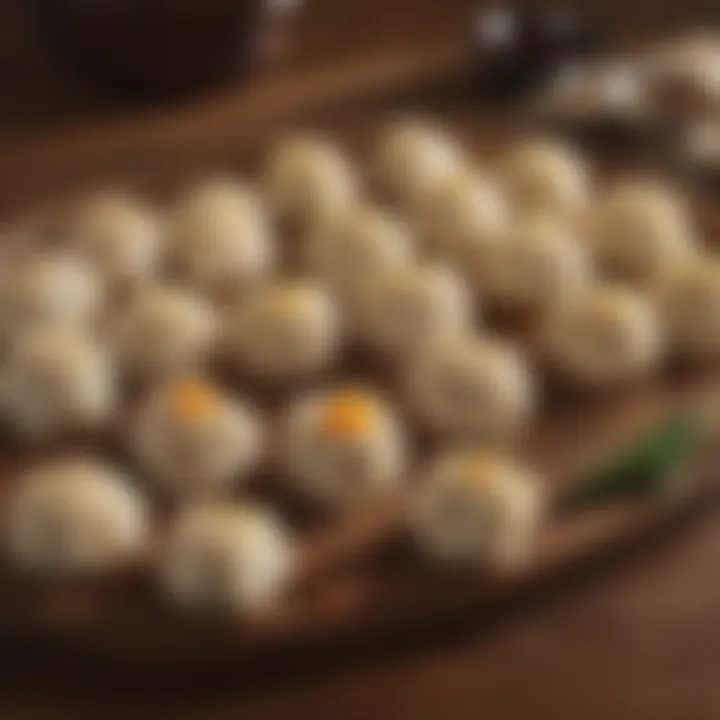
- Protein: Both pork and shrimp are excellent sources of protein, vital for muscle repair and growth. A typical pork and shrimp dumpling can provide around 8-10 grams of protein per dumpling, depending on the filling.
- Fats: Pork, especially the fattier cuts, contributes a significant amount of saturated fat. While some fat is necessary for energy and cellular functions, moderation is key. Opting for leaner pork can help manage fat intake.
- Carbohydrates: The wrappers are made from flour, contributing carbohydrates that provide energy. However, these can quickly add up, especially if you’re indulging in multiple dumplings.
- Fiber: Dipping those dumplings into a vegetable-rich sauce or serving with sides like steamed greens can enhance the fiber content, supporting digestive health.
Consuming dumplings in moderation, along with plenty of vegetables, can create a nutritionally balanced meal that satisfies both the palate and the dietary guidelines.
Health Considerations
With any culinary delight comes the necessity of understanding its health implications. Pork and shrimp dumplings can indeed fit into a healthy diet if approached wisely. Here are some considerations:
- Sodium Levels: Dumpling fillings often contain soy sauce and other seasonings, which can elevate sodium levels. High sodium intake can lead to hypertension. Being mindful about ingredient choices can help mitigate this.
- Allergies: Shrimp is a shellfish, which is a common allergen. It’s crucial for those with shellfish allergies to steer clear or find suitable alternatives.
- Cooking Methods: Steaming is healthier compared to frying. Frying can increase fat content drastically, so opting for steamed dumplings is a wiser choice if health is a priority.
- Portion Control: Dumplings can be deceivingly filling. Knowing when to stop is essential. Serving them alongside a fresh salad or soup can help control portions while adding freshness to the meal.
Combining the enjoyment of dumplings with an awareness of nutritional needs allows individuals to savor the experience fully yet responsibly.
In summary, while pork and shrimp dumplings are a culinary delight, understanding their nutritional value ensures that you can indulge thoughtfully. These dumplings hold not just flavor, but also a range of important nutrients when prepared mindfully.
Common Mistakes to Avoid
In the world of dumpling making, missing the mark can lead to a disaster—a flavorful filling, but a ruined texture or an unappetizing presentation. When it comes to pork and shrimp dumplings, common mistakes can drastically affect not just the dumplings themselves but also the dining experience. Understanding these pitfalls is crucial for both novice cooks and seasoned chefs who wish to elevate their craft.
Mistakes largely stem from impatience or a lack of understanding of the fundamentals. Being aware of these traps ensures that your dumplings don’t just taste good but look and feel right too. By identifying these common errors clearly, cooks can enjoy a smoother experience in the kitchen, resulting in dumplings that delight on the plate and the palate.
Filling Errors
Filling errors can derail even the best-prepped pork and shrimp dumplings before they hit the stove. One prevalent mistake is overfilling. While a generous amount of filling might sound appealing, it often leads to torn wrappers, leaks during cooking, and a messy dining situation. The trick is to strike a balance; a small scoop, about one tablespoon, usually works well for a standard wrapper. This keeps the filling contained while ensuring the dumpling can seal properly.
Another common issue is the texture of the filling itself. If the shrimp or pork isn’t chopped finely enough, the stuffing can become unwieldy. Chopping shrimp into small, uniform pieces ensures that each bite is harmonious, offering both the sweetness of shrimp and the savory notes of pork. Moreover, neglecting to season the filling adequately will leave your dumplings bland. Using soy sauce, ginger, garlic, and scallions can immensely enhance the flavor, turning a standard filling into something special.
"Even the most exquisite wrappers can’t save a poorly seasoned filling. Remember, let the ingredients shine!"
Cooking Mishaps
Cooking mishaps often stem from uncertain temperatures or incorrect techniques. A typical blunder is cooking dumplings at too high a heat. This can lead to a burnt exterior while leaving the inside still raw, which is not only unappetizing but unsafe. Ensuring that your steamer's water is at a gentle simmer can rectify this issue, providing a steam bath that cooks the dumplings through without scorching them.
Boiling is yet another method that comes with its challenges. People often drop dumplings into boiling water all at once, leading to them sticking together. To avoid a sticky situation, it's best to cook them in smaller batches. Stir the water gently after adding the dumplings to prevent them from clinging to one another. Lastly, timing is essential. Getting the cooking duration wrong can lead to sad, undercooked dumplings or rubbery, overcooked ones. Keeping a close eye on your creations will help you learn the optimal cooking time based on your stove and pot.
In summary, avoiding these common mistakes opens the door to crafting delightful dumplings that not only look spectacular but taste divine.
Storing and Reheating Dumplings
When it comes to pork and shrimp dumplings, a delightful blend of flavor and texture can easily be spoiled by improper storage and reheating techniques. Taking time to learn about the right ways to handle leftover dumplings can elevate your culinary experience and minimize food waste. Making sure these tasty parcels stay fresh enhances not just your meals but also the enjoyment in preparing them.
Best Practices for Storage
Here are some essential tips for storing dumplings:
- Cool Down: Allow your dumplings to cool before storing. This step is crucial because trapping heat can lead to condensation, creating a soggy experience later.
- Choose Containers Wisely: Use airtight containers to keep dumplings fresh. A plastic food storage container or a heavy-duty freezer bag can work wonders. For an even better barrier against freezer burn, try layering parchment paper between dumplings if you're stacking them.
- Label and Date: Mark the container with the date you're storing them. Dumplings can typically be stored in the fridge for about three days. If you decide to freeze them, they should ideally be consumed within three months for the best taste.
- Get Creative with Portion Sizes: If you know you won’t finish a large batch, consider portioning out smaller groups. This not only helps in reheating the precise amount you want, but it also maintains quality.
Applying these storage techniques can significantly prolong the life and flavor of your dumplings.
Reheating Techniques
Proper reheating is just as vital as how you store your dumplings. Here’s how you can bring them back to life:
- Steaming: The ideal method for reheating is steaming. Not only does it preserve the moisture, but it also keeps the texture intact. Simply place them in a steamer basket over simmering water for around 5 to 8 minutes. This method effectively revives a fresh-like taste and texture.
- Pan-Frying: If you’re in the mood for a crispy exterior, pan-frying is your go-to technique. Heat a pan with a few drops of oil, place the dumplings and then add a bit of water to create steam; cover the pan for around 6 to 8 minutes. This will give you that delectable crunchy outside and a soft inside.
- Microwave with Caution: While using a microwave is the quickest method, it can lead to rubbery dumplings. If you must use this method, cover the dumplings with a damp paper towel and heat in short bursts of about 30 seconds each, flipping them occasionally.
Steaming and pan-frying not only maintain the freshness of the dumplings but also enhance their original flavor.
- Rebake: Occasionally, if you have dumplings with a baked outer layer, baking them at a low temperature can work well too. Just give them around 10 minutes in a preheated oven at 350°F (175°C), allowing them to crisp back up without drying out.
Utilizing these reheating techniques ensures that your dumplings retain their cherished qualities and taste almost as delightful as when they were first made.
Dumplings in Contemporary Cuisine
In today’s culinary landscape, dumplings like pork and shrimp have made a noteworthy mark, evolving from traditional meals into a canvas for culinary creativity. The significance of dumplings in contemporary cuisine goes beyond their basic form; they serve as a bridge linking generations, culinary traditions, and new flavors. Cooks, whether professionals or home chefs, find themselves exploring the diverse applications of dumplings, adapting them to fit modern palates and dietary preferences.
Dumplings are not just about the stuffing inside a wrapper; they embody a whole philosophy of cooking that emphasizes flavor, texture, and presentation. They offer a balance between comfort food and fine dining, which appeals to a wide audience. For culinary enthusiasts, they reflect the art of deftness; every pleat and fill can signal a cook’s mastery of technique and knowledge of the ingredients involved.
Fusion Dishes
The creative trend of fusion cuisine has propelled dumplings into exciting new realms. Chefs around the world are combining various culinary elements to breathe fresh life into the classic pork and shrimp dumpling. This approach often leads to unexpected flavor profiles that surprise the palate.
Some intriguing fusion examples include:
- Korean BBQ Dumplings: Incorporating marinated bulgogi beef within a traditional dumpling wrapper provides a savory and sweet taste that sets off fireworks on your taste buds.
- Mediterranean Shrimp Dumplings: Mixing shrimp with herbs like dill and spices such as sumac, and then wrapping them in a dumpling skin creates a unique culinary experience. This highlights how versatile the concept of dumplings can be.
- Spicy Taco Dumplings: By infusing spiced ground pork or shrimp with ingredients from classic Mexican tacos—like jalapeños and avocado—these dumplings cater to a more adventurous crowd.
The essence of fusion lies in boundary-pushing culinary exploration, wherein old traditions are reimagined through innovative combinations of flavors and textures, making the dumpling experience both unique and fulfilling.
Innovative Chef Creations
As gastronomy continues to advance, chefs focus on not only taste but also the aesthetic appeal and overall experience. Innovative chef creations involving dumplings often exhibit a deep understanding of global cuisines while embracing local ingredients.
These creations might include:
- Sous Vide Dumplings: Some chefs emphasize precision in cooking by employing sous vide techniques to ensure the filling retains its juiciness while the wrapper achieves perfect doneness.
- Deconstructed Dumplings: This method presents the essence of dumplings in unexpected formats, like plating crisp wonton chips alongside a beautifully stacked filling of shrimp and pork, garnished with dipping sauces that reflect the dumpling's traditional accompaniments.
- Plant-Based Dumplings: With the growing interest in plant-based diets, numerous chefs are crafting dumpling fillings inspired by traditional recipes but made entirely from plant ingredients. Using plant proteins and creative vegetables, they create delicious alternatives that maintain flavor profiles familiar to dumpling lovers.
Dumplings today signify a blend of culinary heritage and contemporary creativity, demonstrating that traditions may evolve without losing their essence.
In summary, dumplings in contemporary cuisine embody a melting pot of flavors and traditions. They invite bold experimentation while standing as a testament to culinary craftsmanship, making them adaptable across cultures and among various dietary needs. This fusion of the old and new gives dumplings a prevailing relevance in modern gastronomy.
Epilogue
In this article, we explored the intricate nature of pork and shrimp dumplings, a delightful culinary creation that not only satisfies the palate but also carries a rich tapestry of cultural significance. As we wrap up our discussion, it becomes clear that these dumplings are more than just a convenient meal option; they are a bridge between tradition and innovation, connecting generations of cooks across various cuisines.
First and foremost, understanding the art of crafting these dumplings offers valuable benefits for home cooks and culinary enthusiasts alike. Mastering the balance of flavors in the fillings, for instance, enhances the taste profile, while learning various cooking methods ensures that the dumplings achieve that coveted texture, be it tender or crisp. The richness of the pork, coupled with the sweet and briny notes of shrimp, creates a delightful harmony that reflects the essence of comfort food.
Moreover, our exploration highlighted the importance of selecting high-quality ingredients. Choosing the right pork and fresh shrimp can dramatically impact the final product. It is often the tiniest nuances—the addition of a splash of soy sauce here or a pinch of ginger there—that transform a good dumpling into an unforgettable one. This precision in culinary practice not only enriches the flavor but also elevates the entire cooking experience.
Additionally, this article illuminated common pitfalls that can undermine the dumpling-making process, such as overfilling or improper sealing techniques. Learning from these mistakes not only boosts confidence but empowers cooks to take the reins in their kitchens creatively.
In a world where convenience often overshadows depth, the art of preparing pork and shrimp dumplings stands as a testament to manual skill, patience, and love for food. The process—from wrapping to cooking—is an experience that encourages mindfulness and connection to cultural heritage. As we conclude this guide, we encourage readers to immerse themselves in the craft, embracing both traditional recipes and imaginative adaptations.
Ultimately, the journey of making dumplings is about more than just food; it is about the joy of sharing, the warmth of family gatherings, and the celebration of heritage. So grab your ingredients and get those hands working. Your dumpling adventure is just a few folds away!
"Cooking is an art, and dumplings are the canvas where flavors and tradition come together."
Key Takeaway:
- Whether you’re a seasoned chef or a kitchen novice, the craft of dumpling-making is open to anyone willing to put in the effort. Stay curious, experiment, and enjoy the delicious outcomes of your culinary endeavors.







